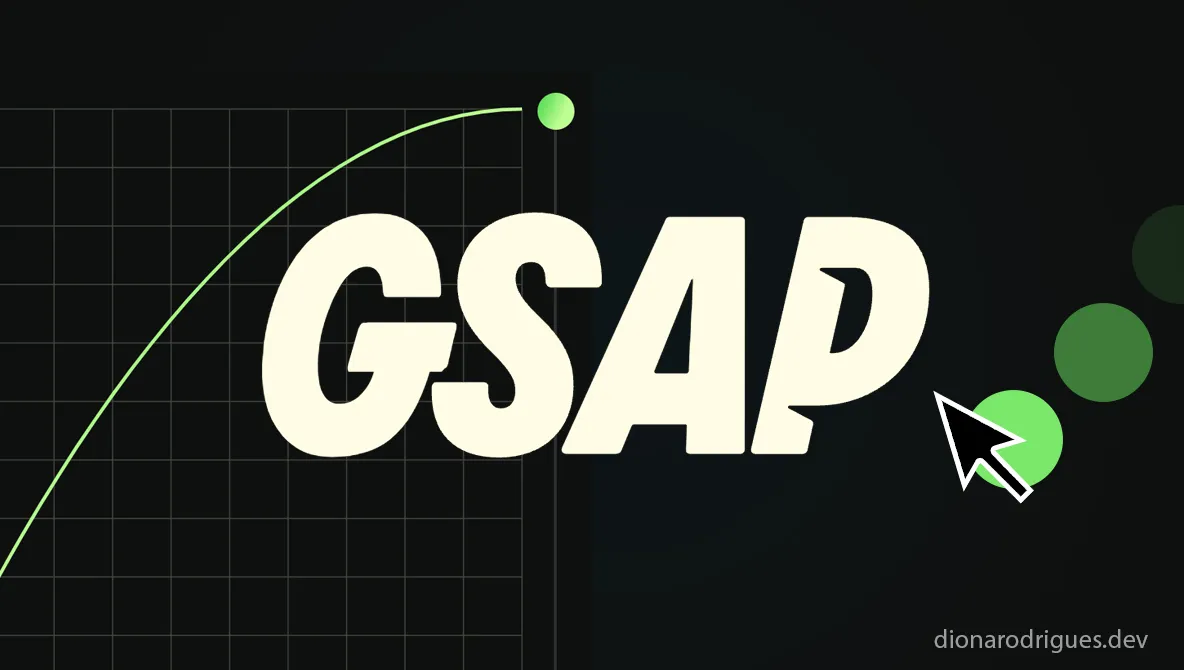Introduction to GSAP
The GreenSock Animation Platform, commonly referred to as GSAP, is a powerful JavaScript library designed for creating high-performance animations on the web. With its rich feature set and user-friendly syntax, GSAP has become a popular choice among developers and designers alike. Since its inception, it has been instrumental in enhancing the visual appeal and interactivity of websites, making it a vital tool in modern web development.
One of the primary reasons for GSAP’s significance lies in its exceptional performance. Unlike many other animation libraries, GSAP optimizes animations to ensure smooth playback regardless of the user’s device capabilities. This is particularly critical in an era where users access websites from a diverse range of devices, each varying in performance. GSAP employs a technique known as “smart sequencing,” which allows developers to control multiple animations precisely, resulting in professional-grade animations that are fluid and responsive.
Furthermore, GSAP’s ease of use is another strong advantage. Its straightforward API simplifies the process of creating sophisticated animations, enabling developers to focus more on their project’s creative aspects rather than getting bogged down in complex coding. Features like timeline control, easing functions, and built-in callbacks make GSAP a versatile tool for animating both simple and intricate elements on a webpage.
When integrated with React, GSAP’s robust functionalities enable developers to build dynamic user interfaces that captivate audiences. The ability to trigger animations based on React’s component lifecycle methods adds a new layer of interactive design, allowing for seamless transitions and visual storytelling. Consequently, GSAP not only enhances the aesthetic quality of web applications but also contributes to a more engaging user experience.
Setting Up Your React Project
To begin utilizing GSAP (GreenSock Animation Platform) in your React project, you must either create a new React application or use an existing one. If you are starting from scratch, you can easily generate a new React application by using Create React App. To do this, open your terminal and execute the command:
npx create-react-app my-gsap-app
Replace “my-gsap-app” with your desired project name. This will set up a new folder containing all the necessary boilerplate code for a fundamental React application.
In the case that you already have an existing React app, ensure that your project is structured accurately, and that your environment is set up for further development. It is essential to have Node.js installed along with a package manager like npm or yarn to manage your project dependencies effectively.
Once your React environment is prepared, the next step is to install GSAP. GSAP can be easily integrated using either npm or yarn, depending on your preference. For users employing npm, simply run the following command in your project directory:
npm install gsap
If you are using yarn, the installation command will look like this:
yarn add gsap
Executing either of these commands will install the GSAP library and add it to your project’s dependencies. After installation, you can verify that GSAP has been added by checking your package.json file, where you should see “gsap” listed under dependencies.
With GSAP successfully installed, you are now prepared to start integrating animations into your React components. The upcoming sections will cover how to utilize GSAP’s powerful animation capabilities to enhance the visual appeal of your application.
Basic GSAP Animation Syntax
GSAP, or GreenSock Animation Platform, offers a powerful and flexible way to animate elements on a webpage. It is particularly advantageous when integrated with React JS, due to its performance and ease of use. Understanding the basic syntax of GSAP animations is key to leveraging its capabilities effectively within your React projects.
The core function of GSAP is the gsap.to() method, which allows you to define animations by specifying the target element, the properties to animate, and the duration. For instance, if you wanted to animate an element to move 100 pixels to the right over a duration of 1 second, the code snippet would look like this:
gsap.to(".my-element", { x: 100, duration: 1 });In this example, .my-element is the target class, x represents the horizontal position, and duration specifies how long the animation should last. GSAP simplifies complex animations with a concise syntax that allows for quick edits and adjustments.
Besides simple translations, GSAP allows for scaling and fading of elements. Scaling can be achieved easily with the scale property. For example, to double the size of an element:
gsap.to(".my-element", { scale: 2, duration: 1 });For fading, the opacity property can be utilized. The following code will fade an element out:
gsap.to(".my-element", { opacity: 0, duration: 1 });This basic overview covers the essential syntax of GSAP, focusing on how to manipulate HTML elements through movement, scaling, and fading. Implementing these simple GSAP animations will enhance the visual presentation of your React applications. By experimenting with these fundamentals, developers can create more intricate animations, paving the way for more dynamic user experiences.
Integrating GSAP with React Components
Integrating GSAP (GreenSock Animation Platform) with React components is a straightforward process that significantly enhances the interactivity and visual appeal of web applications. To effectively implement GSAP animations in both functional and class-based components, developers can leverage the useEffect hook and React refs. This approach not only streamlines the animation process but also ensures that animations are executed in relation to the component lifecycle.
For functional components, the useEffect hook serves as a valuable tool for managing side effects, including animations. By placing the GSAP animation code within useEffect, developers can guarantee that the animations are triggered only after the component mounts. This method prevents animations from starting prematurely and allows for proper cleanup, which is essential for avoiding memory leaks. A common practice is to create a reference to the DOM element that requires animation using the useRef hook. For instance:
const elementRef = useRef(null);useEffect(() => {gsap.to(elementRef.current, { duration: 1, opacity: 1 });}, []);This structure guarantees that the animation targets the correct element and is executed at the appropriate time. Additionally, when using class-based components, the componentDidMount and componentWillUnmount lifecycle methods can be utilized to manage GSAP timelines. In these methods, developers can initiate animations when the component is rendered and reverse or kill the animations when the component is unmounted, ensuring optimal performance.
Moreover, it is important to utilize GSAP’s powerful features effectively. Using callbacks provided by GSAP to handle animation end events can enhance user experience, allowing developers to trigger subsequent actions or animations dynamically. Overall, by integrating GSAP animations carefully with React components, developers can create dynamic, engaging, and performant user interfaces that captivate users and improve overall interaction with the application.
Using GSAP Timeline for Complex Animations
The GreenSock Animation Platform (GSAP) offers a powerful feature known as Timeline, which allows developers to manage complex animations with increased flexibility and ease. By utilizing GSAP’s Timeline, developers can chain multiple animations in a defined sequence, providing greater control over timing and flow. This section delves into how to effectively use the GSAP Timeline in a React JS context.
One of the primary advantages of using a GSAP Timeline is the ability to synchronize animations seamlessly. By creating a timeline, you can add various animations that will play in a specified order, simplifying the process of keeping your animations coordinated. To do this, you can create a new Timeline instance using `gsap.timeline()`, and then add animations using methods such as `.to()`, `.from()`, or `.staggerTo()`. This enables animations to begin one after another or even overlaps where necessary.
Moreover, the Timeline feature supports delays, which are crucial for timing adjustments. You can define delays for each animation sequence, ensuring a smooth transition between them. For instance, using `.to(target, duration, {delay: 1})` will cause the specified animation to commence one second after the previous animation. This can enhance the storytelling in your animations by allowing critical moments to be timed perfectly.
Callbacks are another essential aspect of managing complex animations with the Timeline feature. GSAP allows you to specify functions that will execute after an animation is complete, which can be particularly useful for triggering other animations or events. With the `onComplete` callback, you can effectively sequence actions, ensuring that each animation flows seamlessly into the next.
Here’s a sample code snippet for a more advanced animation sequence using GSAP’s Timeline in React:
import { useEffect } from 'react';import { gsap } from 'gsap';const MyComponent = () => {useEffect(() => {const tl = gsap.timeline();tl.to('.element1', { x: 100, duration: 1 }).to('.element2', { y: 100, duration: 1, delay: 0.5 }).to('.element1', { opacity: 0, duration: 1, onComplete: () => console.log('Animation Complete!') });}, []);return (Animate Me!Me Too!);};export default MyComponent;In conclusion, leveraging GSAP’s Timeline feature in React JS allows developers to create intricate animation workflows. Through chaining animations, defining delays, and using callbacks, GSAP provides a robust system for achieving complex animations with ease and precision.
Responsive Animations in React with GSAP
Creating responsive animations in a React application using GSAP (GreenSock Animation Platform) is essential for providing a smooth and adaptable user experience across various devices. One effective approach to achieving this is by leveraging the power of CSS media queries in conjunction with GSAP’s robust animation library. By integrating screen size detection, developers can dynamically adjust animations to suit different viewport dimensions and orientations.
First, it is crucial to identify the relevant screen dimensions for your application. You can utilize the window.innerWidth property to determine the current width of the browser window. Based on this value, you can create conditional animations. For example, a simple setup might include specifying different animation properties for mobile and desktop versions:
const isMobile = window.innerWidth < 768;if (isMobile) {gsap.to('.element', { duration: 0.5, x: 100, opacity: 0.5 });} else {gsap.to('.element', { duration: 1, x: 200, opacity: 1 });}Additionally, incorporating the ResizeObserver API can greatly enhance the responsiveness of your animations. This API allows you to listen for changes to an element’s size, enabling you to trigger animations that adapt in real-time. For instance, using the following code, you can smooth out any transitions that might occur due to screen size adjustments:
const resizeObserver = new ResizeObserver(() => {if (window.innerWidth < 768) {gsap.to('.element', { x: 75 });} else {gsap.to('.element', { x: 150 });}});resizeObserver.observe(document.body);This methodology ensures that your animations are not only aesthetically pleasing but also functionally relevant, promoting a seamless experience for users navigating on different devices. By continuously monitoring changes in screen size and orientation, you can maintain the integrity of your animations and keep users engaged, regardless of how they’re accessing your application.
Performance Optimization Techniques
When integrating GSAP (GreenSock Animation Platform) animations within a React application, performance optimization is paramount. This is essential not only for ensuring a smooth user experience but also for maintaining the overall responsiveness of the application. There are several best practices that can be implemented to achieve this.
First and foremost, minimizing renders in your React components is crucial. Frequent renders can lead to choppy animations, especially when animations are triggered during a state change. Using the React.memo feature can help prevent unnecessary re-renders by memoizing the component output. Additionally, implementing shouldComponentUpdate or using React’s useCallback and useEffect hooks can also contribute significantly to reducing render frequency.
Furthermore, leveraging requestAnimationFrame is a vital technique for optimizing animations. This method allows the browser to synchronize animations with the display refresh rate, resulting in smoother transitions. By using GSAP’s native functions, which are built around requestAnimationFrame, you can ensure that the animations are executed at the best possible frame rate.
Another area to focus on is avoiding unnecessary reflows, as these can severely impact animation performance. For instance, manipulating the DOM directly should be limited; GSAP can handle changes in a more performance-friendly manner. Additionally, batching DOM updates together can minimize the number of reflow events triggered.
Lastly, GSAP has built-in memory management features that help in efficiently handling resources used during animations. It automatically cleans up and disposes of unused animation instances, which helps in reducing memory overhead. By understanding and applying these optimization techniques, developers can ensure that GSAP animations in their React applications run seamlessly, providing users with an engaging experience without compromising performance.
Debugging GSAP Animations in React
When working with GSAP animations in a React environment, developers may encounter various issues that can hinder the smooth integration of animations. Debugging these animations is essential for ensuring that the user experience remains seamless. One of the primary tools at a developer’s disposal is the browser’s developer tools. Utilizing features such as breakpoints, console logs, and the performance monitor can help identify where animations may be failing or slowing down.
A frequent issue developers face is unresponsive animations, which can often stem from improper lifecycle management. Ensuring animations are correctly invoked during React component lifecycle methods, such as componentDidMount or within useEffect hooks, is crucial. Misplaced animation calls can lead to issues where animations do not initiate as intended. It’s often beneficial to log the state of the properties being animated to ensure they are defined and possess the expected values before the animation starts.
Performance bottlenecks are another common concern. GSAP is designed for high performance, yet in a React application, excessive re-renders or ineffective use of animations can lead to sluggish performance. Utilizing the React.memo or useMemo hooks can help prevent unnecessary renders during state updates. Additionally, it’s important to adhere to animations’ best practices, such as limiting the number of concurrent animations and keeping animations as lightweight as possible, ensuring a smooth user experience.
Understanding the limitations of both GSAP and React is fundamental. Common pitfalls include trying to animate React state variables directly without a proper mechanism in place. Instead, consider managing animations via refs or using GSAP’s built-in features to control properties and states effectively. With the right debugging strategies and awareness of potential issues, developers can enhance their ability to implement effective GSAP animations in their React projects.
Conclusion and Best Practices
As we have explored throughout this blog post, the GreenSock Animation Platform (GSAP) proves to be an exceptional tool for implementing animations within React applications. With its simple syntax and powerful capabilities, GSAP enables developers to create visually engaging and smooth animations that significantly enhance user experience. Whether you are animating elements during component loading or creating intricate timelines, GSAP’s versatility is unmatched in the context of React JS.
When utilizing GSAP animations in your React projects, several best practices can help you maintain an effective balance between aesthetics and usability. First and foremost, it is crucial to ensure that animations serve a functional purpose and are not merely decorative. Thoughtfully designed animations can guide user interaction, draw attention to critical elements, and improve the overall readability of the interface. Aim to use animations sparingly and judiciously; excessive animations may lead to overwhelming experiences that can distract users from the core content.
Moreover, consideration for performance and accessibility cannot be overlooked. Be mindful of the impact that animations may have on loading times and responsiveness. Optimize the animations for mobile devices and older browsers where necessary, while providing alternatives for users who may prefer a static interface due to various reasons, such as sensitivity to motion.
In summary, GSAP offers a remarkable array of tools for animating components in React JS. By applying best practices and considering the overall user experience, developers can leverage the full potential of GSAP to create stunning animations that enrich their applications. We encourage readers to delve deeper into GSAP’s capabilities and experiment with different animation techniques to elevate their React projects to new heights.




